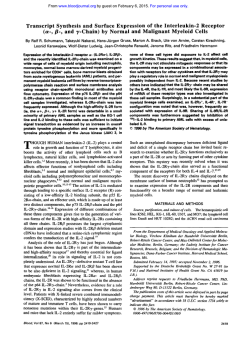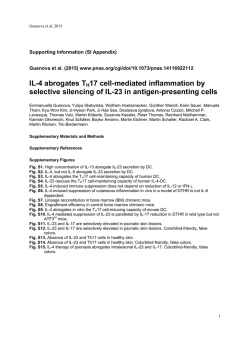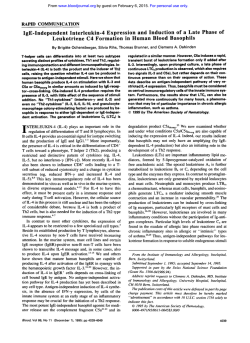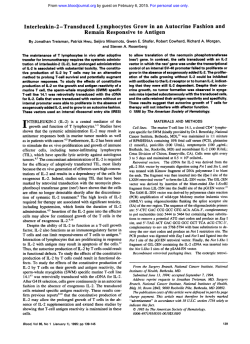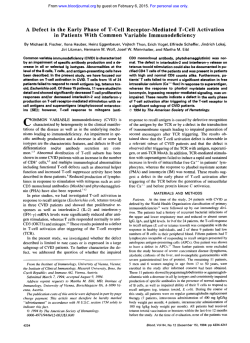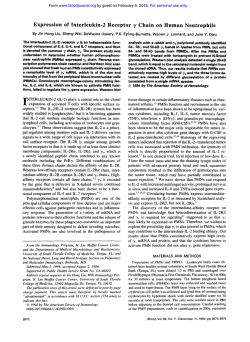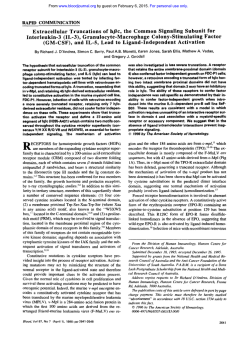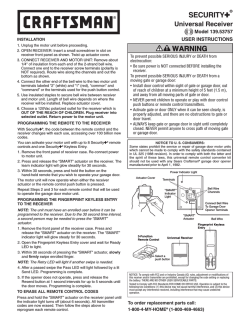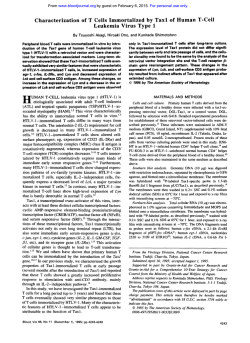
Function of the Interleukin-2 (IL-2) Receptor y-Chain in
From www.bloodjournal.org by guest on February 6, 2015. For personal use only. RAPID COMMUNICATION Function of the Interleukin-2 (IL-2) Receptor y-Chain in Biologic Responses of X-Linked Severe Combined Immunodeficient B Cells to IL-2, IL-4, IL-13, and IL-15 By David J. Matthews, Paula A. Clark, Joan Herbert, Gareth Morgan, Richard J. Armitage, Christine Kinnon, Adrian Minty, Kenneth H. Grabstein, Daniel Caput, Pascual Ferrara, and Robin Callard The interleukin-2 (IL-2) receptor y-chain is a common component of several members of the cytokine receptor superfamily including those for IL-2, IL-4, IL-7, IL-9, IL-15, and possibly IL-13, and has recently been renamed the common y-chain (yc-chain). Transfection experiments have shown that the y.-chain participates in signal transduction by IL-2, IL-4 and IL-7, but a functional role for the y.-chain in biological responses by normal T cellsand B cells to these cytokines has not been established. In this study, we have used X-linked severe combined immunodeficiency (X-SCID) as a naturally occurringy,-chain gene disruption model to examine the role of the y,-chain in human B-cell responses to IL-2, IL-4, IL-13, and IL-15. Our experiments show that B cells from two X-SCID patients with characterized yc-chaingene mutations do not respond to IL-2 or IL-15, but respond as well or better than normal B cells t o both IL-4 and IL-13 in assays for Bcell activation, proliferation, and IgE secretion. This finding raises important questions about the function of the yc-chain in receptors for IL-4 and IL-13, and the nature of the immune defect in X-SCID. 0 1995 by The American Societyof Hematology. F the ye-chain is a signaling component of the receptors for IL-2, IL-4, and IL-7, they do not necessarily establish a role for the ye-chain in biologic responses by T cells and B cells to these cytokines. It has recently been shown that X-linked severe combined immunodeficiency (X-SCID) is caused by mutations in the 7,-chain.” This is a devastating immunodeficiency characterized by profoundly defective cellular and humoral immunity and is uniformlyfatal by 1 to 2years of age unless treated by bone marrow transplantation (BMT).”,” Affected boys have markedly reduced or absent T cells, but B cells arepresent in normal or even increased numbers. B cells fromX-SCID patients can secreteIg on stimulationwith pokeweedmitogen in the presence of normalT cells, but other in vitro assays have uncovered defective responses to mitogens and cytokines.” In addition, the X chromosome is nonrandomly inactivated in both B cells and T cells as well as other hematopoietic cell lineages from obligate carriers of X-SCID indicating ageneexpressedin all thesecell types.’‘.” It is significant that autosomal SCID patients unable to make IL-2“ and mice in which the IL-2 gene was inactivated by targeted gene disruption” have normal numbers of T cells and do not show the same immunologic abnormalities as X-SCID.Therefore, the profoundcell-mediatedandhumoral immunodeficiency in X-SCID is likely to be caused by the combined inability to respond to those cytokines (IL-2, IL-4, IL-7, IL-15, and probably IL-13) whose receptors include the y,-chain as a functional component. In this study we tested B cells from X-SCIDpatients with defined y,-chain mutations for responses to IL-2, IL-4, IL13, and IL- 15. In this naturally occurring y,-chain gene disruptionmodel we showthat the y,-chain is required for responses to IL-2 and IL-15, but not for responses to 1L-4 or 1L-13. These results have important implications for the function of the y,-chain in receptors for IL-4 and IL-13and the B-cell abnormalities in X-SCID. UNCTlONAL high-affinityreceptorsbelonging to the cytokine receptorsuperfamily are commonly heterodimeric or heterotrimeric structures consistingof a cytokine binding chain associated with one or more additional chains required for signal transduction.’ The high affinity interleukin-2 receptor (IL-2R)is a heterotrimeric structurecomposed of a nonsignaling a-chain (Tac) that is not a member of the cytokine receptor superfamily complexed with a P-chain and a y-chain, both of which are members of the cytokine receptor superfamily.’ The IL-2R y-chain has alsobeen identified as a component of the receptors for IL-4,’.‘ IL-7,’ and IL15: andthere isindirect evidence that it may also be a component of the IL- 13receptor.’ The functional importance of the y,-chain in signal transduction by IL-2 hasbeen established in fibroblast transfection experiments showing that its presence in the IL-2R complex is required for protein tyrosine phosphorylation and induction of c-myc, C$IS, and cj ~ nReceptor . ~ internalisation after IL-2 binding also requires a functional y,-chain.’ Similarly, the y,-chain is required for tyrosine phosphorylation of the insulin receptor substrate- I (IRS-I) in response to IL-4,3 and efficient internalisation of the IL-7R on binding of IL-7.’ In other transfection experiments, proliferation of mouse F7 cells to IL-4 or IL-7 required expression of the y,-chain in addition to the I L 4 R or IL-7R.I”Althoughthese experiments clearly show that From the Cellular Immunologyand Molecular Immunology Units, Institute of Child Hedth, London, UK; Sanoji Recherche, Labege, France; and Immunex Corporation, Seattle, WA. Submitted October 1, 1994; accepted October 19, 1994. Supported bygrants from the Leukaemia Research Fund the Medical Research Council. the Wellcome Trust, and the Child Health Research Appeal Trust. Address reprint requests to Robin Callard, PhD, Cellular Immunology Unit,Institute of Child Health, 30 Guilford St, LondonW C l N IEH. UK. The publication costsofthis article were defrayed in part by page chargepayment.Thisarticle must therefore be hereby marked “advertisement” i n accordance with 18 U.S.C. section 1734 solely to indicate this juct. 0 l995 by The American Society of Hematology. 0006-4971/95/8501-0041$3.00/0 38 MATERIALS AND METHODS Two malechildren with no previous family history of SCID were admitted to the Great Ormond Street Hospital for Children (London, UK) for investigation and treatment of Pneumocystis Patients. Blood, Vol 85, No 1 (January l ) , 1995: pp 38-42 From www.bloodjournal.org by guest on February 6, 2015. For personal use only. THEy-CHAIN 39 I N X-SCID B-CELL RESPONSES carinii pneumonia. Patient I (PI). age 4 months on admission, had less than 0.5% CD3' (T cells) and 97% CD19 (B cells). and patient 2 (P2), age 9 months on admission, had between I % and X% CD3' (most ofwhich were ~ 1 6 ' )and X7% CD19' cells in PBMC. IgG and IgA levels were below normal in both patients. IgM was normal in PI and only slightly less than normal in P2. A clinical diagnosis of SCID was made in both cases. Analwis qf yG-chain gene mutations. Single-strand conformational polymorphism (SSCP) analysis and sequencing ofy,-chain genomic DNA has been described in detail elsewhere.'x In brief, individual exons were amplified by polymerase chain reaction (PCR) from genomic DNAofboth patients using primers described by Noguchi et al" or designed from the genomic sequence." The samples were then digested and analyzed by electrophoresis on nondenaturing polyacrylamide gels containing 5% glycerol at room temperature for 5 hours at 30 W. Amplified regions of the gene that indicated a band shift were then sequenced using a Sequenase kit (USB, Little Chalfont, UK) to determine the exact nature ofthe mutation. For Southern blots, 5 pg of genomic DNA was digested with To9 I (New England Biolabs. UK) or Msp I (Life Technologies Inc. Bishop A Tag l M 2.9 - P1 N Msp I M P1 N + 8.1 ' "4B 1.9 PATIENT 2 NORMAL G 1 A . e--T C. ~ - Stortford, UK) as recommended by the manufacturer. Digested DNA was separated on a 0.8% agarose gel, transferred onto Hybond N' membrane (Amersham International, Ayelsbury, UK), and hybridized to radiolabeled ye-chain cDNA. Preparation of B cells from PBMC and cell culture. Peripheral blood mononuclear cells (PBMC) were prepared by centrifugation of heparinized venous blood over Ficoll-sodium diatrizoate (Lymphoprep: Flow Laboratories, Rickmansworth, UK). E- (B) cells were obtained by E-rosetting with AET-treated sheep red blood cells to deplete T cells as described previously."' In B-cell activation experiments, isolated E- cells at a concentration of IO" cellslmL in 200 p1 of RPMI 1640 supplemented with 5% FCS and 25 mmoVL HEPES were cultured in flat-bottomed microtiter wells with IL-4 ( 1 0 0 UlmL) or IL-13 (100 nglmL) for 72 hours. The cells were then washed and double stained with PE-conjugated anti-CD19 (Becton Dickinson, Oxford, UK) to identify B cells and either FITC-conjugated anti-CD23 (The Binding Site, Birmingham, UK) or FITCconjugated anti-IgM (Tago, Botolph Claydon, UK) and examined on the FACScan (Becton Dickinson, Oxford, UK). Cells were gated to identify CD19' B cells, and IgM and CD23 expression shown as histograms of fluorescence intensity against number of CD19' (B) cells.'" In proliferation assays, E- cells at a concentration of 10' cellslmL in 200 pL of RPMI 1640 supplemented with 5% FCS and 25 mmol/L HEPES were cultured in flat-bottomed microtiter wells with anti-IgM conjugated to polyacrylamide beads (Metachem Diagnostics Ltd. Northhants, UK) at I O pglmL plus rhIL-2 (Amersham International), rhlL-4 (kindly supplied by Stirling Drug Inc,Malvern, PA), rhlL-13 (Sanofi Recherches, Labege, France), or recombinant simian IL-15 (Immunex Corp, Seattle. WA) at predetermined optimal concentrations. Control cultures contained B cells with anti-IgM or medium alone. The cultures were incubated for 3 days at 37°C then pulsedwith I pCi of'HTdR for 12 hours before harvesting. Incorporated radioactivity was determined on a liquid scintillation counter and expressed as mean dpm ? I SEM of triplicate cultures. For Ig production, E- cells at a concentration of IO" cells/mL in 200 pL of Iscove's IMDM medium supplemented with 5% FCS and 25 mmol/L HEPES were cultured for 8 days in round-bottomed microtiter wells with soluble recombinant homotrimeric human CD40 ligand (CD4OL trimer) plus either rhIL-4 ( I 00 UlmL), rhIL13 (100 nglmL), or rhIL-IO (kindly supplied by Dr Anne O'Garra, DNAX, Palo Alto, CA) at predetermined optimal concentrations. Supernatants were then removed and assayed by enzyme-linked immunosorbent assay (ELISA) for IgM, IgG, IgA, and IgE as described previously." - " I_M, Fig 1. Mutational analysis ofy,-chaingene. (A) Genomic DNA from P1, the mother of P1 (MI and an unaffected control IN) were digested with Msp I or Taq I and examined by Southern blot analysis with a full-length radiolabeled ye-chain cDNA probe. With Msp I digestion, DNA from an unaffected control and the mother of P1 gave t w o fragments of approximately8.1 and 1.9 kb whereas only the 1.9kb fragment was present in P1. With Taq I digestion, DNA from an unaffected control gave a strongly hybridizing fragment of approximately 5.8 kb and a less intense species of 2.9 kb. The fragment of 5.8 kb was apparently reduced in size to about 4.4 kb in DNA from P1. Digests from the mother of P1 showed all three fragments consistent with heterozygosity at this locus and confirming her status as a carrier. (B) SSCP analysis ofPCR amplified DNA from P2 indicated a possible mutation in exon 5 (results not shown). The PCR product of exon 5from P2 and an unaffectedcontrol was analyzedby dideoxynucleotide sequencing. P2 showed a single base deletion of a G at position 665 indicated by the arrow. Unaffected control: 5' ACGTITCGTGlTC 3'; P 2 5' ACGTITC.TGlTC 3'. RESULTS Analvsis of y,-chain mutations. PCR analysis of genomic DNA from patient 1 with exon specific primers" suggested a minimum deletion of about 1.4 kb consisting of all or part of exon 5 and all of exons 6.7, and 8 of the 7,-chain gene including the exons encoding the WSXWS motif and the transmembrane domain. The deletion was confirmed by Southern blot analysis with whole 7,-chain cDNA (Fig IA). PCR amplification followed by single-strand conformational polymorphism (SSCP) analysis of genomic DNA from P2 suggested a possible mutation in exon 5 of the y,-chain gene. Sequencing of this exon showed a single base-pair deletion at position 665 (cDNA numbering taking first nucleotide of initiation codon ATG as 1) in the patient compared with a normal control resulting in a frame shift with a premature stop codon at position 814 (Fig IB). This mutation predicts a truncated protein of 271 amino acids that also lacks the WSXWS motif and the transmembrane domain. From www.bloodjournal.org by guest on February 6, 2015. For personal use only. MATTHEWS ET AL 40 least equivalent toIgE secretion by control B cells from unaffected donors. In other experiments B-cell Ig production in response to costimulation with sCD40L trimer and IL-2 or IL-15 was IL-15 and antip determined. B cells from normal donors stimulated in this IL-15 way made Ig of all classes (IgM, IgG, and IgA) except for IgE (Table 2). In contrast, X-SCID B cells costimulated with IL-2 and antip sCD4OL and IL-2 or IL-15 failed to produce any IgM, IgG, IL-2 or IgA. To showthat this wasnot caused by an intrinsic inability of X-SCID B cells to make JgM, IgC, or IgA, B cells were also costimulated with sCD40L and IL-10. IL-l0 IL-13 and antip IL-13 wasused because the IL-l0 receptor is a member of the class I1 cytokine receptor super family which is not thought to include the ?,-chain as a receptor component.25In these IL4 and antip 1L-4 experiments, significant amounts of IgM, IgG, and IgA were secreted by both X-SCID B cells and B cells from normal controls (Table 2). anti U Medium Activation of X-SCID B cells. In the experiments described above, both proliferation and Ig production depended on costimulation of B cells with cytokine and either antiI l I I I I 1 0 20 40 0 M iW 0 50 ?W IgM or CD40L. To investigate B-cell responses to IL-4 and IL- 13 in the absence of a second activation signal, we mea’H Thymidine incorporation(DPM x IO-’) sured the increase in expression of surface IgM and CD23. Fig 2. Proliferation of B cells costimulated with anti-lgM and ILIn at least four separate experiments, the expression of both 2, IL-4, IL-13, or IL-15. Peripheral blood (E-) B cells from PI, P2, and markers was increased on B cells from normal controls actinormal controls were stimulated with anti-lgM and IL-2, 11-4,11-13. vated with either IL-4 or IL-13, although the effect of ILor IL-15 at predetermined optimal concentrations. Control cultures contained B cells with anti-lgM or medium alone. The cultures were 13 was significantly less than that of IL-4 (Fig 3, A through incubated for 3 days at 37°C then pulsed with 1 pCi of 3HTdR for 12 D). Similar differences between IL-4 and IL-13 have been hoursbeforeprocurement.Incorporatedradioactivitywasdeter~ ~ ~activation ~ of X-SCID B cells mined on a liquid scintillation counter and expressed as mean disin- reported p r e v i o ~ s l y . ’IL-4 also consistently enhanced expression of bothsIgMand tigrations per minute of triplicate cultures2 1 SEM. CD23 (Fig 3, E, F, I, J). In all four experiments, the increase in sIgM on X-SCID B cells was comparable with the increase on normal unaffected B cells. However, in some experiments Proliferation of X-SCID B cells in response to IL-2, ILthe increase in CD23 on X-SCID B cells appeared less than 4, IL-13, and IL-15. Proliferation of B cells from both Xthe increase obtained with unaffected B cells. This was not SCID patients to IL-2, IL-4, IL-13, and IL-15 was examined a consistent finding and it is not clear at this stage whether in costimulation assays with anti-IgM. As expected, B cells it reflects a weaker activation response indicated by CD23 from both patients were unable to respond to IL-2 whereas expression of X-SCID B cells to IL-4. Interestingly, the significant proliferation was obtained with B cells from unafexpression of sIgM and CD23 on X-SCID B cells induced fected controls (Fig 2). Interestingly, X-SCID B cells also with IL-13 was equivalent to that induced with IL-4. This failed to respond to IL-15. This novel cytokine is produced observation contrasts with the much weaker expression inby a wide variety of different cell types in addition to T duced by IL-13 activation of normal B cells (Fig 3, G, H, cells and has many properties in common with IL-2.” The K, L). The significance of the enhanced response to IL- 13 receptor for IL-15 shares the IL-2RO-chain and the ?,-chain by X-SCID B cells is not yet clear, but it suggests that the with the IL-2R but not the IL-2Ru-chain (Tac).6 In contrast ?,-chain may serve to limit responses to IL-13. to the lack of response to IL-2 or IL-15, X-SCID B cells proliferated strongly when stimulated with IL-4 or IL-13. DISCUSSION The responses of B cells from both patients to IL-4 and ILOur experiments show unequivocally that the ?,-chain is 13 was equivalent to or greater than that of normal B cells required for biologic responses by B cells to 1L-2 andIL-15, (Fig 2). These results show clearly that the ?,-chain is required for human B-cell proliferation to IL-2 and IL- 15 but Table l.IgE Production by X-SCID B Cells not IL-4 or IL-13. IgE secretion by X-SCID B cells stimulated with CD4OL IgE Secretion InglmL) plus IL-4 or IL-13. Both L 4 and L 1 3 are known to induce Stimulus Patient 1 Control IgE secretion by B cells activated through CD40.22-24 To <2 <2 Medium determine the role of the ?,-chain in this response, we inves<2 <2 Control sn tigated IgE secretion by X-SCID B cells costimulated with 2 2 1 <2 sCD40L IL-4 or IL-13 and a homotrimeric form of soluble CD40 20 z 4 22 c 2 sCD40L + IL-4 ligand (sCD40L trimer). As shown in Table 1, IgE produc25 2 3 40 5 100 sCD40L + I L - l 3 tion by X-SCID B cells in response to IL-4 or IL-13 was at Normal I Patient 1 Patient 2 P l I From www.bloodjournal.org by guest on February 6, 2015. For personal use only. B-CELL THE 7-CHAIN IN X-SCID Table 2. Ig Production by X-SCID B Cells Stimulated With rCD4OL and IL-2, IL-15, or 11-10 Control Patient 1 Stimulus lgM* Medium Control SN sCD40L sCD40L IL-2 sCD40L IL-15 sCD40L + IL-10 63 30 -t 2 75 t 11 75 t 35 45 t 6 45 t 13 4381 2 98 + + IgG' t5 69 t 21 81 13 t 11 69 t 3 <20 170 >10,000 t 50 IgA' <l0 <l0 105 2 5 <l0 <l0 lgM* 24347 2 5 50 t 7 443t 20 7201,244 t 165 687 903 t 92 >3,324 10,000 IgG* IgA' 25 t3 28 140 t 8 ? 38 t 56 t 71 1,359 2 60 t2 t2 56 t 20 75 t 24 1,605 t 31 t 54 * lg secretion in nglrnL. but not for B-cell activation, proliferation, or IgE secretion in response to L - 4 or IL-13. The 7,-chain has been shown to be a component of the IL-4 receptor.334It has also been shown in transfection experiments to be required for signal transduction and cell proliferation in response to IL-4.3*10 CD23 SlgM E ILJ P1 IL-13 IL-4 P2 Fluorescence Intensity Fig 3. Surface IgM and CD23 expression on X-SCID B cells e&vated with 11-4or IL-13. Peripheral blood E- cells were cultured at lO'/mL in 200 pL flat-bottomed microtiter wells with IL-4 (100 U/ mL), L 1 3 (l00 ng/mL), or medium alone(M) for 72 hours. The cells were double stained with PE-conjugated anti-CD19 to label B cells and either FlTGconiugated antl-CD23or anti-lgM and examined on the FACScen. Cells were gated onthe FL2 channal to identify CD19' B wlls and dgM and CD23 expreuion shown as histogramsof fluormacmce intensityagainstcellnumbercompared with unstained wlls (C). Nevertheless, it is apparent from our experiments that the IL-4R p140 chain without the 7,-chain, but perhaps in association with other unidentified receptor components, is sufficient for IL-4 activation of B cells. Although IL-4 and IL-13 have many biologic activities in common, they do not share the same receptor.'.% The IL-13 receptor has not yet been characterized but a relationship between the receptors for IL-4 and L-13 has been established by blocking experiments with the IL-4 mutant IL4Y124D that binds to the I L 4 R p140 chain but does not signal." In competitive inhibition studies, IL4y124~has been found to inhibit response to both IL-4 and IL-13.','6 This observation has led to the suggestion that the receptors for IL-4 and IL-13 share a common ~ u b u n i tAlthough .~ the most likely candidate for a common receptor component is the ?,-chain, our results show that expression of a functional 7,-chain is not required for B-cell activation, proliferation, or IgE secretion in response to IL-4 or IL-13. However, the presence of the 7,-chain in the receptors for IL-4 and IL-13 may be important for regulating the affinity of the receptors, or serve some other unknown function. The reason why biologic responses to IL-2 and IL-15 require a functional 7,-chain whereas responses to IL-4 and IL-13 do not is unclear. Interestingly, the receptors for IL2 and IL-15 share both the IL-2R @-chainand the 7,-chain, but they are known to have distinct a-chains.6 Although the IL2R a-chain is important for affinity of IL-2 binding, it has a very short intracellular domain and does not signal.' Accordingly, IL-2 and IL-15 may activate the same signal transduction pathways with the same or very similar biologic responses. Our experiments show that the 7,-chain is vital for receptor signaling by both of these cytokines. Our findings are also important for understanding the mechanism of the immune deficiency in X-SCID. The ability of X-SCID B cells to respond to both IL-4 and IL-13 suggests that the B-cell immunodeficiencies in these patients may be caused by defective responses to other cytokines or simply to an absence of T-cell help. The IL-7R has also been shown to include the 7,-chain, but the presence of normal numbers of recirculating mature B cells in these patients suggests either that IL-7 is not required for B-cell development in humans or that biologic responses to IL-7 also do not require a functional 7,-chain. This question is currently being investigated. An intrinsic B-cell defect in X-SCID is nevertheless indicated by the nonrandom distribution of Xchromosome inactivation in B cells from obligate carriers. From www.bloodjournal.org by guest on February 6, 2015. For personal use only. MATTHEWS ET AL 42 This finding could be explained if responses to IL-2 and IL15, which we have shown to require an intact y,-chain, convey an advantage on B cells or memory B cells for longterm survival. On the other hand, the presence of normal numbers of recirculating B cells in X-SCID patients which respond to IL-4 and IL- 13 suggest that the ovemding abnormality is defective T-cell development which is responsible indirectly for the loss of humoral immunity. This finding may have important implications for future therapy in this disease. ACKNOWLEDGMENT We thank Dr K. Sugamura for the ?,-chain cDNA probe. REFERENCES 1. Cosman D: The haematopoietin receptor superfamily. Cytokine 5:95, 1993 2. Taniguchi T, Minami Y: The IL-2flL-2 receptor system: A current overview. Cell 73:5, 1993 3. Russell SM, Keegan AD, Harada N, Nakamura Y, Noguchi M, Leland P, Friedmann MC, Miyajima A, Pun RK, Paul WE, Leonard WJ: Interleukin-2 receptor gamma chain: A functional component of the interleukin-4 receptor. Science 262:1880, 1993 4. Kondo M, Takeshita T, Ishii N, Nakamura M, Watanabe S , Ami K-I, Sugamura K: Sharing of the interleukin-2 (IL-2) receptor gamma chain between receptors for IL-2 and IL-4. Science 262:1874, 1993 5. Noguchi M, Nakamura Y, Russell SM, Ziegler SF, Tsang M, Cao X, Leonard WJ: Interleukin-2 receptor gamma chain: A functional component of the interleukin-7 receptor. Science 262:1877, 1993 6. Giri JG, Ahdieh M, Eisenman J, Shanebeck K, Grabstein K, Kumaki S, Namen A, Park LS, Cosman D, Anderson D: Utilization of the beta and gamma chains of the 1L-2 receptor by the novel cytokine IL-15. EMBO J 13:2822, 1994 7. Zurawski SM, Vega F, Huyghe B, Zurawski G: Receptors for interleukin 13 and interleukin 4 are complex and share a novel component that functions in signal transduction. EMBO J 12:2663, 1993 8. Asao H, Takeshita T, Ishii N, Kumaki S , Nakamura M, Sugamura K: reconstitution of functional interleukin 2 receptor complexes on fibroblastoid cells: Involvement of the cytoplasmic domain of the gamma chain in two distinct signalling pathways. Proc Natl Acad Sci USA 904127, 1993 9. Takeshita T, Asao H, Ohtani K, Ishii N, Kumaki S , Tanaka N. Munakata H, Nakamura M, Sugamura K: Cloning of the gamma chain of the human 1L-2 receptor. Science 257:379, 1992 IO. Kawahara A, Minami Y, Taniguchi T: Evidence for a critical role for the cytoplasmic region of the interleukin 2 (L-2) receptor gamma-chain in IL-2, IL-4 and IL-7 signalling. Mol Cell Biol 14:5433, 1994 1 1. Noguchi M, Yi H, Rosenblatt I", Filipovich AH, Adelstein S , Modi WS, McBride OW, Leonard WJ: Interleukin-2 receptor gamma chain mutation results in X-linked severe combined immunodeficiency in humans. Cell 73:147, 1993 12. Fischer A: Severe combined immunodeficiencies. Immunodef Rev 3:83, 1992 13. Conley ME: Molecular approaches to analysis of X-linked immunodeficiencies. Annu Rev Immunol 10:215, 1992 14. Conley ME, Lavoie A, Briggs C, Brown P, Guerra C, Puck JM: Nonrandom X chromosome inactivation in B cells from carriers of X chromosome-linked severe combined immunodeficiency. Proc Natl Acad Sci USA 85:3090, 1988 15. Goodship J, Malcolm S, Lau YL, Pembrey ME, Levinsky RI: Use of X-chromosome inactivation analysis to establish carrier status for X-linked severe combined immunodeficiency. Lancet 1 :729, 1988 16. Disanto JP, Keever CA, Small TN, Nichols GL, O'Reilly RJ, Flomenberg N: Absence of interleukin 2 production in a severe combined immunodeficiency disease syndrome with T cells. J Exp Med 171:1697, 1990 17. Schorle H, Holtschke T, Hunig T, Schimpl A, Horak I: Development and function of T cells in mice rendered interleukin-2 deficient by gene targeting. Nature 352:621, 1991 18. Clark PA, Lester T, Jones AM, Levinsky RJ, Kinnon C: Screening for mutations causing X-linked SCID by SSCP analysis: Identification of two possible hotspots. Hum Mol Genet 1995 (submitted) 19. Callard RE: Human B cell responses to cytokines, in Balkwill F (ed): Cytokines: A Practical Approach. Oxford, UK, IRL, 1991, p 121 20. Rigley KP, Thurstan SM, Callard RE: Independent regulation of interleukin 4 (IL-4) induced expression of human B cell surface CD23 and IgM: Functional evidence for two IL-4 receptors. Int Immunol 3:197, 1991 21. Grabstein KH, Eisenman J, Shanebeck K, Rauch C, SrinivaSan S , Fung V, Beers C, Richardson J, Schoenborn MA, Ahdieh M, Johnson L, Alderson MR. Watson JD, Anderson DM, Gin JG: Cloning of a T cell growth factor that interacts with the beta chain of the interleukin 2 receptor. Science 264:965, 1994 22. Rousset F, Garcia E, Banchereau J: Cytokine-induced proliferation and immunoglobulin production ofhuman B lymphocytes triggered through their CD40 antigen. J Exp Med 173:705, 1991 23. Punnonen J, Aversa G , Cocks BG, McKenzie ANJ, Menon S , Zurawski G, Malefyt RDW, de Vries JE: Interleukin 13 induces interleukin 4 independent IgG4 and IgE synthesis and CD23 expression by human B cells. Proc Natl Acad Sci USA 90:3730, 1993 24. Defrance T, Carayon P, Billian G, Guillemot J-C, Minty A, Caput D, Ferrara P Interleukin 13 is a B cell stimulating factor. J Exp Med 179:135, 1994 25. Liu Y,Wei H-Y, Ho A S-Y, de Waal Malefyt R, Moore KW: Expression cloning and characterisation of a human IL-IO receptor. J Immunol 152:1821, 1994 26. Aversa G , Punnonen J, Cocks BG,Malefyt RDW, Vega F, Zurawski SM, Zurawski G , de Vries JE: An interleukin 4 (IL-4) mutant protein inhibits both IL-4 or IL-13 induced human immunoglobulin G4 (IgG4) and IgE synthesis and B cell proliferation: Support for a common component shared by IL-4 and IL-13 receptors. J Exp Med 178:2213, 1993 27. Kruse N. Tony HP, Sebald W: Conversion of human interleukin-4 into high affinity antagonist by a single amino acid replacement. EMBO J 11:3237, 1992 From www.bloodjournal.org by guest on February 6, 2015. For personal use only. 1995 85: 38-42 Function of the interleukin-2 (IL-2) receptor gamma-chain in biologic responses of X-linked severe combined immunodeficient B cells to IL-2, IL-4, IL-13, and IL-15 DJ Matthews, PA Clark, J Herbert, G Morgan, RJ Armitage, C Kinnon, A Minty, KH Grabstein, D Caput and P Ferrara Updated information and services can be found at: http://www.bloodjournal.org/content/85/1/38.full.html Articles on similar topics can be found in the following Blood collections Information about reproducing this article in parts or in its entirety may be found online at: http://www.bloodjournal.org/site/misc/rights.xhtml#repub_requests Information about ordering reprints may be found online at: http://www.bloodjournal.org/site/misc/rights.xhtml#reprints Information about subscriptions and ASH membership may be found online at: http://www.bloodjournal.org/site/subscriptions/index.xhtml Blood (print ISSN 0006-4971, online ISSN 1528-0020), is published weekly by the American Society of Hematology, 2021 L St, NW, Suite 900, Washington DC 20036. Copyright 2011 by The American Society of Hematology; all rights reserved.
© Copyright 2026
